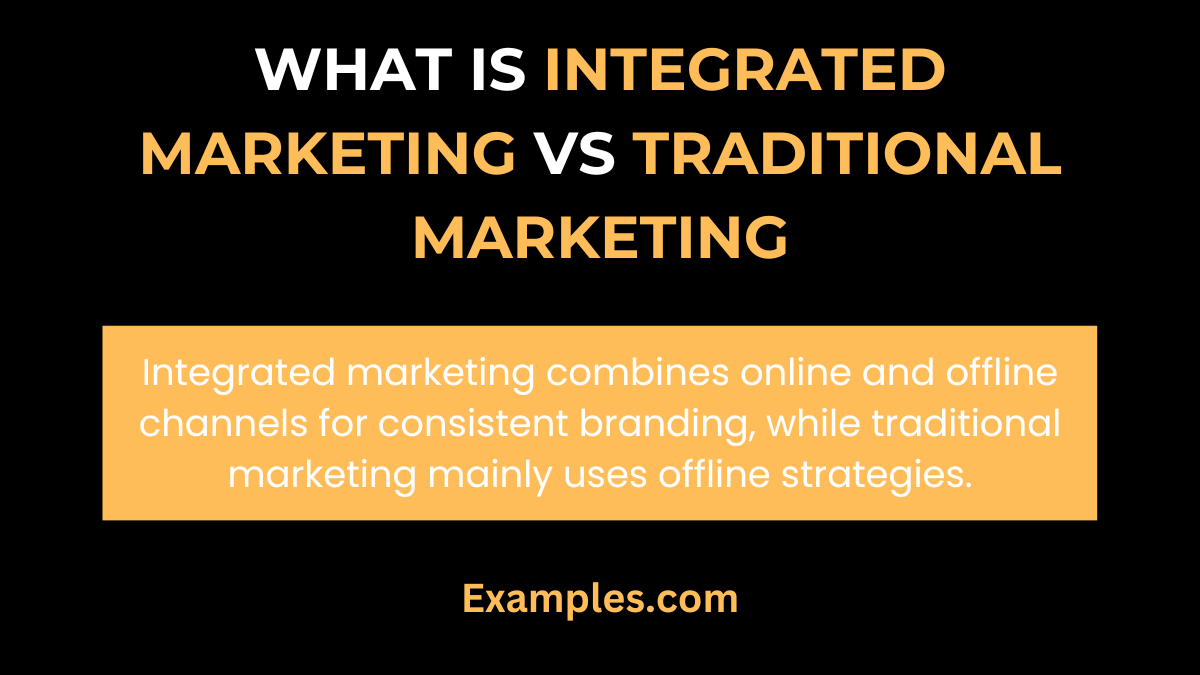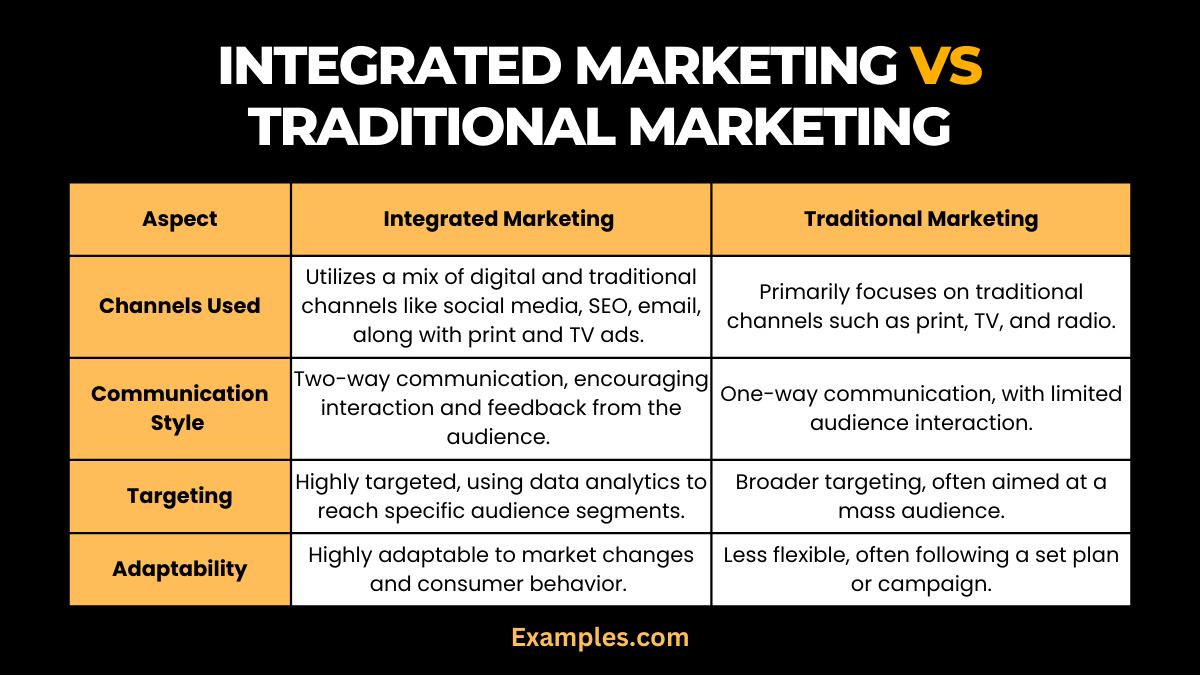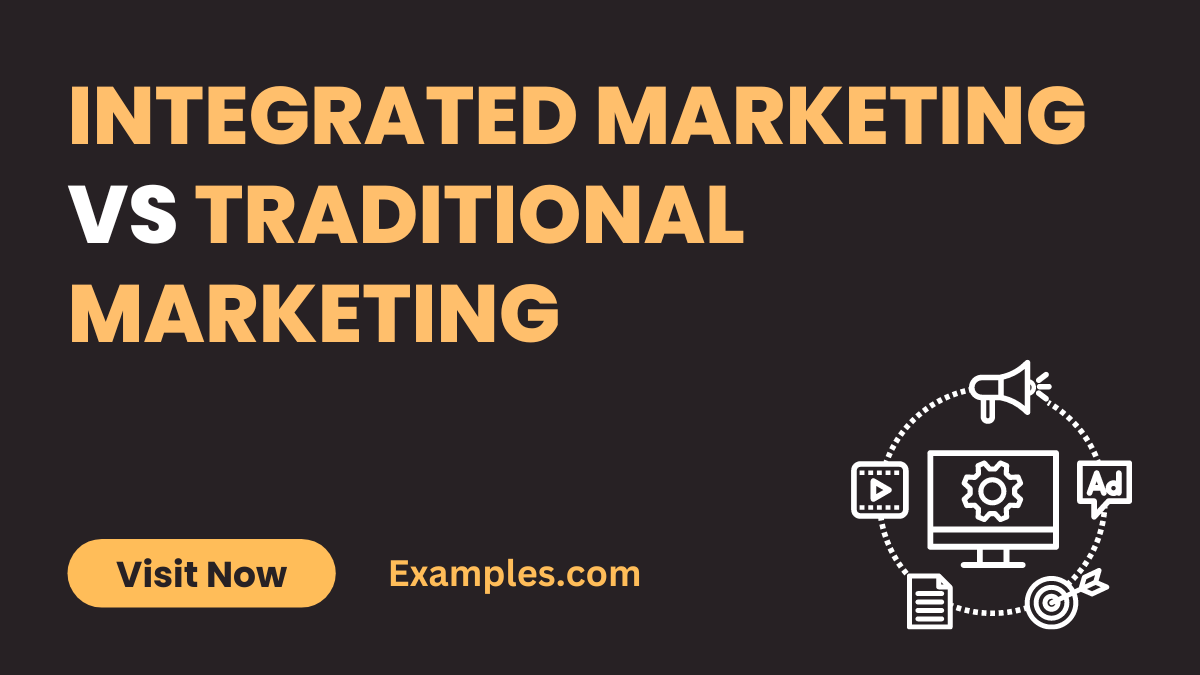19+ Integrated Marketing vs Traditional Marketing Examples
In the ever-evolving landscape of marketing communication, understanding the differences between integrated marketing and traditional marketing is essential. Integrated marketing leverages a variety of marketing communication examples to create a seamless experience for the consumer, blending multiple channels and strategies. It contrasts with traditional marketing, which often relies on single-channel, straightforward messaging. This guide delves into the nuances of both, equipped with real-world examples to illustrate how each approach can be effectively utilized in today’s market.
What is Integrated Marketing vs Traditional Marketing?

Integrated marketing is a strategic approach that combines various communication and marketing methods to create a cohesive and consistent message across all channels. This modern approach focuses on ensuring that all integrated marketing communication efforts, whether online or offline, work together seamlessly. Traditional marketing, on the other hand, relies on conventional methods like print, TV, and radio advertising. It often operates in silos, with each channel working independently, lacking the cohesive strategy characteristic of integrated marketing.
Difference Between Integrated Marketing And Traditional Marketing

| Aspect | Integrated Marketing | Traditional Marketing |
|---|---|---|
| Channels Used | Utilizes a mix of digital and traditional channels like social media, SEO, email, along with print and TV ads. | Primarily focuses on traditional channels such as print, TV, and radio. |
| Communication Style | Two-way communication, encouraging interaction and feedback from the audience. | One-way communication, with limited audience interaction. |
| Targeting | Highly targeted, using data analytics to reach specific audience segments. | Broader targeting, often aimed at a mass audience. |
| Measurement | Emphasizes on measurable results through data and analytics. | Less emphasis on granular measurement, more on reach and frequency. |
| Adaptability | Highly adaptable to market changes and consumer behavior. | Less flexible, often following a set plan or campaign. |
10 Examples of Integrated Marketing
Integrated marketing combines various marketing disciplines to provide a unified, customer-centric experience. Here’s a closer look with examples:
- Social Media Campaigns Aligned with Offline Events: Enhance brand presence by synchronizing social media efforts with offline events.
Example: Launching a social media hashtag campaign during a live product launch event. - Email Marketing Combined with Direct Mail: Bridge digital and physical marketing by aligning email campaigns with direct mail.
Example: Following up a product catalog mail with a targeted email promotion. - Content Marketing Supported by Paid Ads: Use content marketing to provide value, while paid ads increase visibility.
Example: Promoting a well-researched blog post through targeted Facebook ads. - Customer Feedback Integration: Incorporate customer feedback across all channels to improve products and messaging.
Example: Using survey feedback to tailor email marketing content. - Unified Brand Messaging Across Platforms: Ensure consistent brand messaging across digital and traditional platforms.
Example: Aligning the tone and style of TV ads with social media posts. - Cross-Promotion Between Online and Offline Channels: Promote online content in-store and vice versa to create a cohesive brand experience.
Example: Offering exclusive in-store discounts to followers on Instagram. - Influencer Collaborations with PR Events: Combine influencer marketing with PR events for wider reach and authenticity.
Example: Inviting influencers to a product launch event and having them share their experience online. - SEO Strategies Tied with Print Marketing: Link online content to print materials through QR codes or URLs.
Example: Including QR codes in print ads that lead to an informative landing page. - Webinars and Online Workshops: Host online events that complement and expand on your product offerings.
Example: Organizing a webinar series related to your product’s use cases. - Loyalty Programs Across Channels: Implement loyalty programs that customers can engage with both online and offline.
Example: A points system that rewards both online purchases and in-store interactions.
10 Examples of Traditional Marketing
Traditional marketing involves classic approaches that have stood the test of time. Here’s an exploration with examples:
- Print Advertising in Magazines and Newspapers: Utilize print media to reach a specific audience with targeted messaging.
Example: Placing a well-designed ad in a niche industry magazine. - Broadcast Advertising on TV and Radio: Leverage the wide reach of TV and radio for mass-market appeal.
Example: Creating a memorable radio jingle for a local business. - Direct Mail Campaigns: Send physical mail like brochures or postcards to engage customers directly.
Example: Mailing holiday-themed catalogs to a list of past customers. - Outdoor Advertising: Use billboards and signage to capture attention in high-traffic areas.
Example: Strategically placing a billboard near a busy highway for maximum exposure. - Trade Shows and Events: Participate in industry events to connect with customers and showcase products.
Example: Setting up an interactive booth at a major industry trade show. - Telemarketing: Reach out to potential customers directly via phone to promote products or services.
Example: Conducting a call campaign to inform customers about a new service offering. - In-Store Promotions: Create compelling in-store displays and promotions to drive sales.
Example: Launching an in-store contest to increase customer engagement. - Word-of-Mouth Marketing: Encourage satisfied customers to spread the word about your business.
Example: Creating a referral program that rewards customers for bringing in new clients. - Networking and Personal Selling: Build relationships through personal interactions and networking events.
Example: Attending local business mixers to expand professional connections. - Point-of-Purchase Displays: Utilize strategic displays at the point of purchase to influence buying decisions.
Example: Setting up an eye-catching product display at checkout counters.
Each example demonstrates how traditional marketing techniques, though different from integrated marketing strategies, remain relevant and effective in reaching and engaging audiences.
Comparison Between Integrated Marketing vs Traditional Marketing
- Scope of Reach: Integrated marketing combines digital channels with traditional ones, reaching a wider and more diverse audience. Traditional marketing often limits its reach to the audience of specific media like TV or newspapers.
- Engagement Level: Integrated marketing facilitates higher engagement through interactive platforms like social media, while traditional marketing typically offers limited interaction.
- Customization and Personalization: The use of digital tools in integrated marketing allows for more personalized and tailored messaging, unlike traditional marketing which often uses a one-size-fits-all approach.
- Cost-Effectiveness: Integrated marketing can be more cost-effective due to the use of digital channels, whereas traditional marketing, especially mediums like television and print, can be more expensive.
- Tracking and Analytics: Integrated marketing provides detailed insights and data analytics, allowing for better tracking and optimization of campaigns. Traditional marketing lacks this level of detailed tracking and real-time analytics.
Relationship Between Integrated Marketing vs Traditional Marketing
- Complementary Nature: Integrated marketing often incorporates elements of traditional marketing, using them in tandem with digital strategies for a holistic approach.
- Evolution from Traditional to Integrated: Integrated marketing represents an evolution from traditional marketing, adapting to the changing digital landscape and consumer behavior.
- Brand Consistency: Both strategies strive for brand consistency, but integrated marketing achieves this across a broader range of channels and platforms.
- Foundational Role of Traditional Marketing: Traditional marketing methods still form the foundation for many integrated marketing strategies, especially in terms of brand recognition and reach.
- Transition in Consumer Interaction: The move from traditional to integrated marketing reflects a shift in how consumers interact with brands, favoring more interactive and digital channels.
Integrated marketing represents the evolution of marketing strategies, blending traditional methods with digital innovations to create a more cohesive, targeted, and interactive approach. This contrast with traditional marketing highlights the importance of adapting to the digital era, where consumer engagement and data-driven insights are key. Understanding these differences is crucial for businesses aiming to effectively communicate and connect with their audience in today’s diverse and dynamic marketplace.



